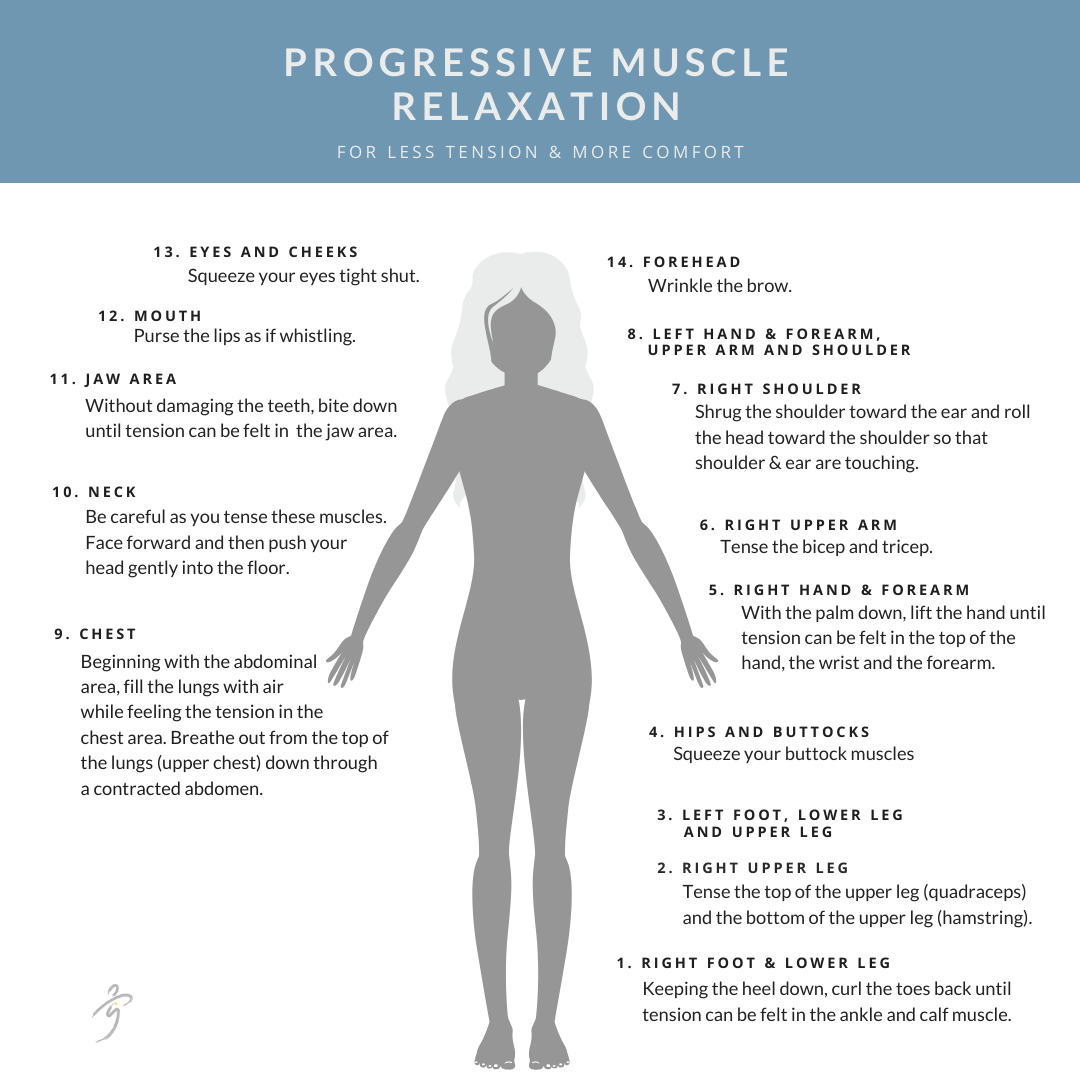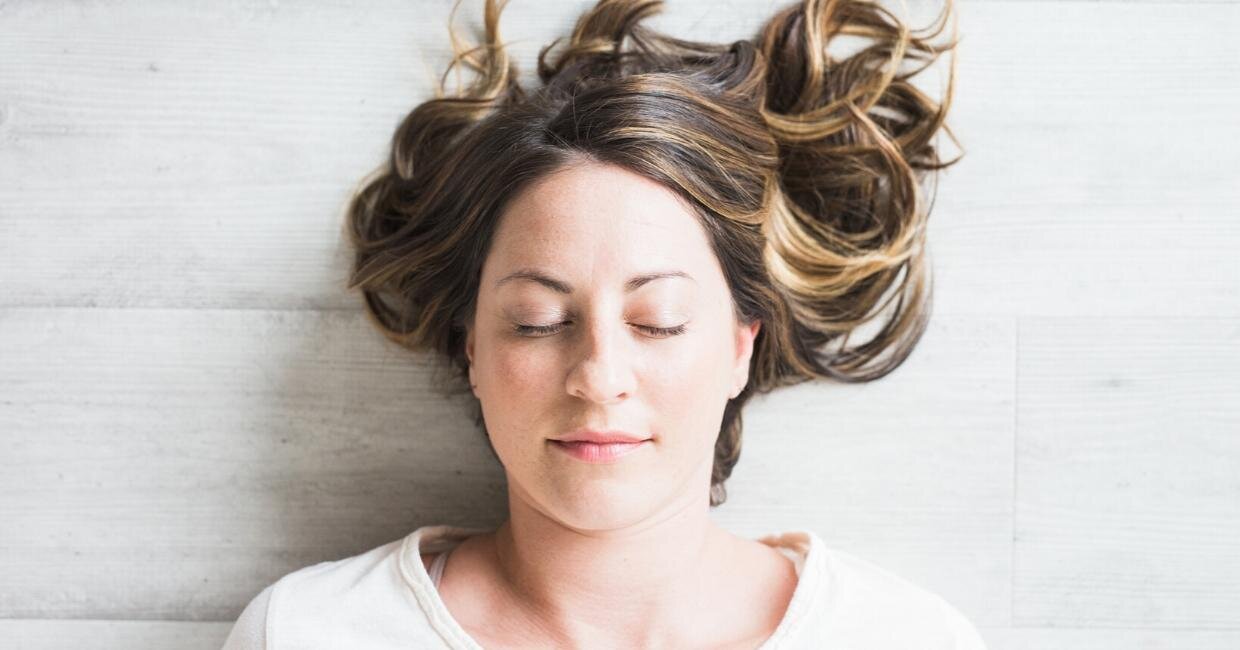Progressive Muscle Relaxation To Relieve Stress + Reduce Muscular Tension
Taking time to feel how we tense and the process of letting can be a crucial part of reducing muscular tension.
Do you find yourself holding on to tension?
If you suffer from complex pain, then you know what it's like to feel tense. Maybe it feels like you're muscles are gripping and aching all of the time. Perhaps for you, everything you do feel like a lot of work and a lot of effort. Or maybe simple activities like cooking or tending to your home sometimes feel impossible.
So what can you do?
Our ability to soften and relax directly impacts how we move, and how we move impacts our capacity to soften and relax. Taking time to feel how we tense and the process of letting can be a crucial part of reducing muscular tension. So for this post, we'll explore one practice that will help to let go.
The Progressive Muscle Relaxation Technique is easy to learn. Once you have it mastered, you can do it anywhere! The more you do it, the faster you'll feel the benefit. Speaking of benefits. Research shows that this practice offers some serious perks! It can help you to develop a sense of well-being, lower blood pressure, decrease muscle tension, reduce anxiety, and decrease fatigue.
Don't underestimate the power of discernment.
The general intention of Progressive Muscle Relaxation is to hone in on your ability to relax by intentionally comparing relaxed and tense states.
Each time you intentionally pay attention to what it feels like to engage your muscles and then let go, you enhance your ability to sense the activity of your muscles. Over time, you can learn to identify unnecessary tensions earlier on and let them go. With less time spent contracting unnecessarily, you can reduce the aches and stiffness that you experience. It can also be a powerful tool for learning how to disrupt your physical patterns of stress and anxiety and stress.
I bet there are times when you don't even notice how tense your muscles have become until you start to ache. Perhaps you clench your teeth slightly, so your jaw feels tight, or maybe your shoulders or back begin acting up. Well, I'm here to tell you that there are many tell-tell signs that stress is taking over — either as an immediate response or as an ongoing state. Just take a look at the two lists below.
CHRONIC STRESS:
PHYSICAL SIGNS
Increased or irregular blood pressure
Insomnia
Tight muscles
Restlessness
Shallow, rapid breathing
Rapid pulse
Elevated cholesterol
Digestive upset
Weight change
Change in blood sugar
Tight throat
Cold extremities
Sweating
Breathing difficulties
Blurred vision
Headaches
Lack of energy
Back or neck ache
Knot in stomach
CHRONIC STRESS:
EMOTIONAL SIGNS
Irritability
Forgetfulness
Boredom
Feeling of ‘emptiness’
Lack of concentration
Anxiety
Anger
Discouragement
Decreased libido
Feeling hopeless or helpless
Lowered psychological resistance
Confusion
Worrying
Fear
Like anything in life, growing your ability to calm takes practice. Taking time to practice the Progressive Muscle Relaxation technique for a few weeks, will help you to develop the capacity to use it quickly and effectively whenever you’re feeling stressed or anxious. Add in a little dose of mindfulness that includes noticing any of the above symptoms and …voilà you’ll refine your ability to notice what your feeling and to have the ability to shift your state when it’s necessary.
I encourage you to enjoy the process. Don’t be in a rush to shift your state. Give yourself the gift of taking a moment to feel your stress response. You don’t need to linger here for a long time. If it becomes overwhelming, turn your attention outward first. Look around your environment and sense the safety of your space. Then actively seek to relax or calm yourself.
There are two basic parts to progressive relaxation: 1) the activation and holding of a specific muscle group, and 2) the relaxation or letting go of the action with the exhale.
Preparing For Relaxation:
When you are first beginning to practice Progressive Muscle Relaxation exercises, start by doing the practice resting on your back on a firm surface if possible. You can place a padding or pillow beneath your head and a pillow or two under your knees. This will allow some of your postural muscle to release so that you can more easily access the calm/relaxed state.
Keep In Mind:
Physical injuries. If you have any injuries, or a history of physical problems that may cause muscle pain, always consult your doctor before you start.
Select your surroundings. Minimize the distraction to your five senses. Such as turning off your phone, the television, and turning down the lights.
Make yourself comfortable. Sit or lay on a surface that is firm, yet comfortable. Make sure you have support for your head. Wear loose clothing, and take off your shoes.
Internal mechanics. Avoid practicing after big, heavy meals, and do not practice after consuming any intoxicants, such as alcohol.
The Process
It’s important to note that there are different ways of practicing progressive relaxation. The one we’ll explore to encourages a slow release of the muscles. However, during another session, you might want to explore a quick release rather than a gradual unfurling.
First, bring your attention to a muscle group, I suggest starting at your feet and working your way up. As you focus on a muscle group, simply notice what you feel — your contact with the floor, a general sense of tension or ease. Then gradually begin tensing the muscle group; hold that tension for five seconds. Then relax your muscles with a long, slow exhale so that the tension feels like it’s draining from your body. As you move through the process, tell yourself or visualize “all the tension is draining from my body.” After you release a muscle group, pause and rest in this relaxation for at least 10 seconds before you go on. This can be repeated several times before moving on to the next muscle group.
Progressive Muscle Relaxation Precautions
If you have a history of muscle spasms or ongoing pain from an injury, talk to your doctor first. There’s a chance that tensing your muscles too tight could make your muscle spasms worse.
Also, if you have low blood pressure then you’ll want to get up very slowly when doing this or any other relaxation exercise. Make sure to transition to lying on your side and rest there for a moment. Then come up to sit, and pause there for a moment. Finally, slowly find your way up to stand when you feel ready. Remember that standing up too quickly could make you feel lightheaded or faint.
+ References
- Mohd. Razali Salleh. Life Event, Stress and Illness. Malays J Med Sci. 2008 Oct; 15(4): 9–18.
- Chellew K, et. al. The effect of progressive muscle relaxation on daily cortisol secretion. Stress. 2015;18(5):53844.
- Sheu S., et. al. Effects of Progressive Muscle Relaxation on Blood Pressure and Psychosocial Status for Clients with Essential Hypertension in Taiwan. Holistic Nursing Practice, 2003; 17 (1), 4147.
- Yunping Li, et. al. Progressive Muscle Relaxation Improves Anxiety and Depression of Pulmonary Arterial Hypertension Patients. Evidence Based Complementary and Alternative Medicine. Volume 2015, Article ID 792895, 8 pages.
- Nuray Dayapoğlu, PhD, et. al. Evaluation of the Effect of Progressive Relaxation Exercises on Fatigue and
- Sleep Quality in Patients with Multiple Sclerosis. J Altern Complement Med. 2012 Oct; 18(10): 983–987.
RELATED POSTS:








